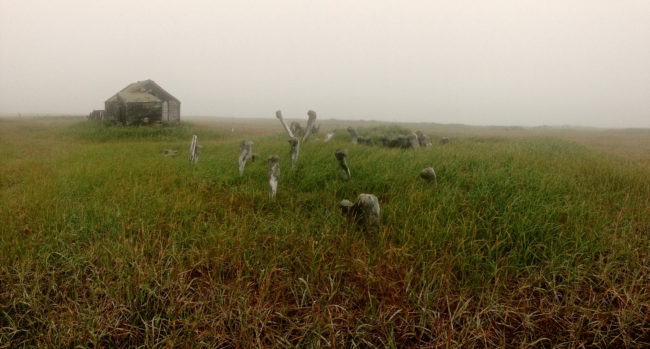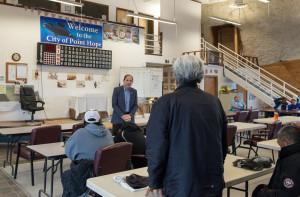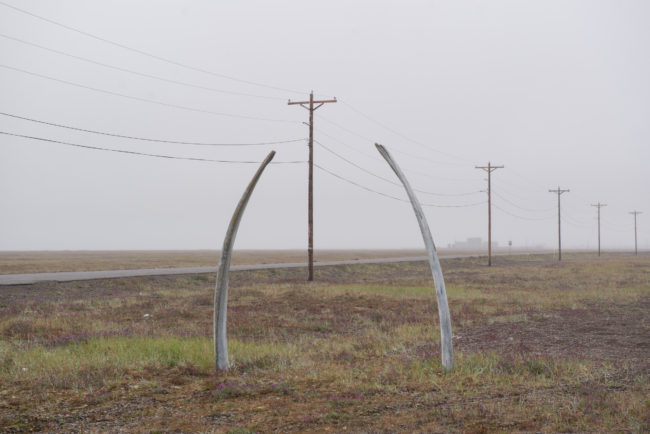
Walking amongst the old sod and whalebone houses on the edge of the Bering Sea, it’s easy to let the world around you fade away. We’ve come to Point Hope, Alaska, one of the oldest continuously inhabited communities in North America, 200 miles north of the Arctic Circle.
The barrier between the old abandoned town site and the new community is the airport, which sees multiple small-plane departures and arrivals each day, though today is a bit different. Today a pearly white plane is parked on the runway. On the side it reads “United States of America,” which feels like a million miles away from where we are.

The official aircraft came all the way from Washington DC to made good on a request from local. Leonard Barger, Transportation Director of the Native Village of Point Hope, wrote to the Secretary of Veterans Affairs, Robert McDonald, last year requesting a visit to honor the community’s veterans.
Barger explained the importance of McDonald’s visit to the 49thstate. With the highest number of veterans per capita in the country, even the most remote communities throughout Alaska have vets. Along with Point Hope, Barger acknowledged the veterans in communities like Barrow, Point Lay, and Unalakleet. “All these people in Alaska, they’re going to Afghanistan,” Barger said, “they’re leaving their family, but they’re serving their country, they’re sacrificing their lives for us.”
Along with visiting Point Hope, McDonald also held a listening session that day in Kotzebue. It took Walter Sampson, a Vietnam vet living in Kotzebue, 11 years to get serviced by the VA in Anchorage, a 500-mile journey and a $600 plane ticket away from home. Sampson made sure to remind McDonald of the unique challenges that many of Alaska’s vets face in accessing the benefits they’ve earned.

“Remember that we’re in bush Alaska,” Sampson said, “We’re in roadless communities.” While Fairbanks and Anchorage have the clinics, the VA officers, and the hospitals, he stressed that, “for bush Alaska we’ve got nothing at all.”
Without the VA facilities and representatives, information has a hard time reaching vets in bush Alaska. Sampson expressed a feeling that many vets seemed to share. “As a veteran, do I really know who [the] VA is?” Sampson asked himself. “What benefits does it have for me?
Sampson is frustrated by the convoluted nature of the VA support system, which often requires multiple phone calls, website logins, and, in the end a system too complex for its own good. McDonald was quick to acknowledge those inefficiencies.
“Walter’s right,” McDonald admitted, “we’ve got too many 1-800 numbers, it’s too confusing.” With over 900 1-800 numbers and 14 websites that require different usernames and passwords, many vets get lost in the system before they ever get help. “We’re going to go to one 1-800 number, we’re going to go to one website,” McDonald promised, “it’s just too complex, we’ve got to simplify it, that’s what we’re working to do.”
But a simplified system is only one step towards getting vets throughout Alaska the benefits they deserve. With McDonald gone and many questions left unanswered, the support system that seems the most promising comes from within the state.
Chester Ballot, another Vietnam vet in Kotzebue, was trained in Anchorage as a tribal veteran representative and now works to sign up fellow vets to the VA. The Alaska VA also sent two representatives to both Point Hope and Kotzebue to sign up and inform vets of their benefits. So far the Alaska VA has sent representatives to 39 of the state’s nearly 300 villages.
Although McDonald is back in DC, Leonard Barger hopes this will not be his last visit to Point Hope. Barger and other community members encouraged him to return in the spring to take part in a whale hunt, one of the many benefits of living on the edge of the Bering Sea.
